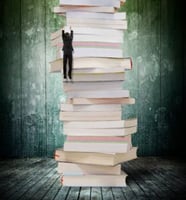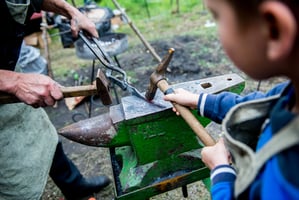The study of literature presents interesting difficulties for teachers and students. More than most...
The Spiral Curriculum: Letting Go of Mastery
Although we debate about modes and methods, educators mostly acquiesce to the need to assess student proficiency. The problems start when, in the search for appropriate measures, we toss around words like “mastery.” As ELA teachers, we of all people should be aware of the importance of word choice. “Mastery” stresses us out because in teaching literature, what is it that we are asking students to “master” exactly? How does one master a text? We’ve been interpreting, reinterpreting, and debating Shakespeare’s texts for a few centuries now. Have we mastered them?
 Several months ago, I, along with a group of teachers, was working through one of those crazy, quirky poems by e.e. cummings. (Did he write any other kind?) At the end of the session we had learned a lot about strategies for reading and finding meaning in a complex work of poetry and we had discovered some treasures within the poem itself, but we were nowhere near “mastering” that text. If we had been given a standardized test the results would have been iffy. The poem was undeniably complex on many levels and we were using CCSS prescribed close reading strategies, but where did all that leave us in terms of mastery? Did we just need to spend more time hammering away at syntax and allusions until. . . ?
Several months ago, I, along with a group of teachers, was working through one of those crazy, quirky poems by e.e. cummings. (Did he write any other kind?) At the end of the session we had learned a lot about strategies for reading and finding meaning in a complex work of poetry and we had discovered some treasures within the poem itself, but we were nowhere near “mastering” that text. If we had been given a standardized test the results would have been iffy. The poem was undeniably complex on many levels and we were using CCSS prescribed close reading strategies, but where did all that leave us in terms of mastery? Did we just need to spend more time hammering away at syntax and allusions until. . . ?
Jerome Bruner’s theory on cognitive growth offers a perspective. A psychologist, professor, and cognitive learning theorist, Bruner’s (1960) hypothesis is that “any subject can be taught in an intellectually honest form to any child at any stage of development” (p. 33)[1]. He believes that this can be accomplished through what he has called the spiral curriculum.
Key features of Bruner’s spiral curriculum are as follows:
- The student revisits a topic, theme, or subject several times throughout their school career.
- The complexity of the topic or theme increases with each revisit.
- New learning has a relationship with old learning and is put in context with the old information.
Bruner’s ideas are foundational to the design of Inquiry By Design’s curriculum. The redundancy of tasks within the sessions is “by design,” giving students several brief passes at content/material and multiple reps of the same skills in order to strengthen and refine them. The goal is movement not mastery. We use texts as tools for thinking and talking about ideas, but we don’t expect to master those texts. We expect that at the end of one cycle of work we will be smarter about not only the ideas in the story, poem, or article, but about how to find meaning in all texts.
When we approach literacy in this spiraling way, we can release the notion that “we can’t move on until this passage/skill is tackled and hogtied.” We take a brief pass and then we move on, because we know we will get another pass, and another. It’s helpful to think of each session as one thin layer of paint on a wall. We would never throw the whole bucket of paint at a wall and expect the desired outcome. Nor can we expect to throw a whole bucket of content at students and expect success—and yet that’s what we’re doing when we insist on mastery over movement.
[1] Bruner, J. (1960). The Process of Education. Cambridge, MA: The President and Fellows of Harvard College.
.png?width=512&height=129&name=logo-hor%20(7).png)


